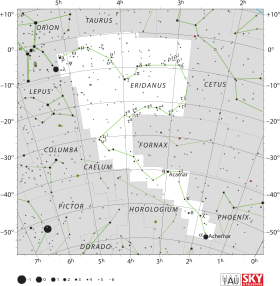Désignations
Theemim, Theemin, Beemin,
υ2 Eri,
52 Eri,
CD −30 1901,
CPD −30 631,
FK5 170,
GC 5614,
HD 29291,
HIP 21393,
HR 1464,
PPM 280424,
SAO 195148
[ 7] , [ 8] modifier
Upsilon2 Eridani (υ2 Eridani / υ2 Eri) est une étoile géante de la constellation de l'Éridan [ 7] magnitude apparente de 3,82[ 2] années-lumière Terre [ 1] Theemin (ou Theemim) et Beemin [ 2] , [ 8] Union astronomique internationale le 1er février 2017Upsilon3 Eridani .
Upsilon2 Eridani est une étoile géante jaune évoluée de type spectral G8+III [ 3] red clump fusion de l'hélium dans son noyau[ 9] rayon solaire et elle est 149 fois plus lumineuse que le Soleil [ 5]
↑ a b c d e et f (en) F. van Leeuwen , « Validation of the new Hipparcos reduction », Astronomy & Astrophysics vol. 474, no 2, novembre 2007 , p. 653–664 (DOI 10.1051/0004-6361:20078357 Bibcode 2007A&A...474..653V arXiv 0708.1752 ↑ a b c d e et f (en) HR 1464 , database entry, The Bright Star Catalogue, 5th Revised Ed. (Preliminary Version), D. Hoffleit and W. H. Warren, Jr., CDS ID V/50 . Consulté le 9 juin 2009.↑ a et b (en) Philip C. Keenan et Raymond C. McNeil , « The Perkins catalog of revised MK types for the cooler stars », The Astrophysical Journal Supplement Series vol. 71, octobre 1989 , p. 245 (DOI 10.1086/191373 Bibcode 1989ApJS...71..245K ↑ (en) G. A. Gontcharov , « Pulkovo Compilation of Radial Velocities for 35 495 Hipparcos stars in a common system », Astronomy Letters vol. 32, no 11, novembre 2006 , p. 759 (DOI 10.1134/S1063773706110065 Bibcode 2006AstL...32..759G arXiv 1606.08053 ↑ a b et c (en) E. Anderson et Ch. Francis , « XHIP: An extended Hipparcos compilation », Astronomy Letters vol. 38, no 5, mai 2012 , p. 331 (DOI 10.1134/S1063773712050015 Bibcode 2012AstL...38..331A arXiv 1108.4971 ↑ (en) HD 29291 , database entry, Catalog of Apparent Diameters and Absolute Radii of Stars (CADARS), 3rd edition, L. E. Pasinetti-Fracassini, L. Pastori, S. Covino, and A. Pozzi, CDS ID II/224 . Consulté le 9 juin 2009.↑ a et b (en) * ups02 Eri -- High proper-motion Star sur la base de données Simbad Centre de données astronomiques de Strasbourg .↑ a et b p. 123, The Cambridge Guide to the Constellations , Michael E. Bakich, Cambridge University Press, 1995, (ISBN 0-521-44921-9 .
↑ (en) S. Alves et al. Determination of the spectroscopic stellar parameters for 257 field giant stars », Monthly Notices of the Royal Astronomical Society vol. 448, no 3, avril 2015 , p. 2749–2765 (DOI 10.1093/mnras/stv189 Bibcode 2015MNRAS.448.2749A arXiv 1503.02556
